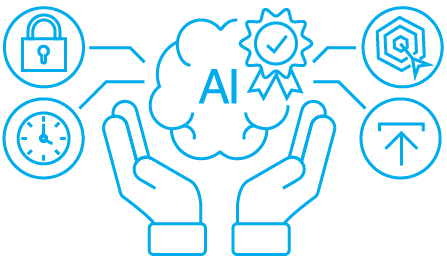- Data Management Platform - use case
- Finding look-alike segments through a DMP
- DMP in business: using 2nd party data to find new clients
- Results: how to use a DMP in online campaigns
- 3 best uses of a DMP in marketing
- Using a DMP in business - conclusion
Overview:
- Data Management Platform – use case
- DMP in business: using 2nd party data to find new clients
- Finding look-alike segments through a DMP
- Results: how to use a DMP in online campaigns
- 3 best uses of a DMP in marketing
DMP use cases can clearly show marketers how to use data management platforms to improve marketing. In simple words – how to sell more with a DMP technology. Here you can find one detailed case study and the most profitable DMP business use cases.
Data Management Platform – use case
There are many ways how to use a DMP in business but we’ll focus just on the most popular and efficient methods. Let’s start from a DMP case study – from a campaign that we conducted for one of the mountain resorts in Europe. Next, to show you more examples of DMP use cases, we’ll list a few techniques that work. Ready?
Our client – one of the largest mountain resorts in Eastern Europe – wanted to know the profiles of clients: what interests them, what is important for the audience. By better knowing users profile, the resort wanted to deliver them personalized ads and increase the number of reservations in four objects.

To look deeply into user profiles, we used our DMP which made it easy to discover audience insights by using 1st party data (owned by the client). We used our DMP because it has access to a huge database of user profiles from all over the world. However there are many platforms, for example, salesforce DMP or Oracle DMP, but use cases generally stay the same. To learn more about DMP, check our another post – What is a Data Management Platform?
Thanks to Audience Reports that are automatically and instantly generated on our DMP, we checked profiles of visitors of five different web pages: four main pages of mountain resorts and an online shop where clients can make a reservation.
By Big Data analysis we discovered behavior, interests, demographics and purchase intentions of web visitors. What’s more, thanks to detailed user analysis, we identified profiles of best converting users and reached them in online campaigns with personalized messages.
Finding look-alike segments through a DMP
Targeting current visitors can bring great results but to reach a significantly larger audience we needed to use 3rd party data. So we looked for new clients with similar profiles of the best converting users on clients’ websites.
To find them, we used our data warehouse which is one of the world’s largest and provide over 27 B user profiles, so we could easily find profiles with the right attributes and deliver them ads of the resort. Finding look-alikes in 3rd party database is one of the most popular and efficient business use cases of a DMP. We also used 3rd party data in remarketing, RTB and search campaigns.
Analyzing post-campaign statistics, we discovered that a large group of audience needs to see an ad multiple times to convert. Over 21% of all target users need more than 8 contacts with ad to convert.
So even if a user is potentially interested in making a reservation, he or she won’t perform the desired action when we display the offer for the first or second time. Of course, you have to find a balance in displaying banners to not annoy your customers but increase the number of conversions.
DMP in business: using 2nd party data to find new clients
Another DMP use case is to collect data from partners and make a profit from this source. In our campaign, to find new customers we launched a content marketing campaign in cooperation with large publishers and popular influencers. It allowed us to reach to new audience group interested in skiing and winter sports.
An implemented pixel on pages with articles made it possible to collect the data about readers (2nd party data) on our DMP and then – deeply analyse their profiles. After we had learned who our readers are, we reached them with personalized campaigns and the statistics showed that it is a highly valuable group of clients.
We achieved a high conversion rate in a conducted content marketing campaign – it reached over 9.41%. The CTR was also impressive and exceeded 26%. Activities based on 2nd party data also generated a new set of profiles which we could use, e.g. in remarketing campaigns to significantly increase the number of total reservations.
Results: how to use a DMP in online campaigns
The best DMP use case is the one that had generated business results. In the case study of using our DMP, the results made our client more than happy. During the cooperation with the client, the DMP was the foundation of our all marketing activities. It made it possible to gather all audience data, analyze user profiles, find the best converting ones and activate the data on global DSP platforms to deliver them personalized ads.
What’s more, on one platform we could analyze the results of the running campaigns. And thanks to analysis, conducted activities could be constantly optimized.
Big Data analysis and optimization helped us to achieve great ROI: 234.80%, which was the most important KPI for our client. Statistics in conducted content marketing campaigns are also impressive and gave us valuable fuel for targeting the right groups in online campaigns.
3 best uses of a DMP in marketing
In the digital era, we generate a huge amount of data every second. So marketers are investing in technology for data management to make better data-driven decisions. According to IAB, advertisers spent nearly 5 billion dollars for data management solutions only in the US (+25% growth). They can choose from such platforms as salesforce DMP, Oracle or Adobe Audience Manager and to use them efficiency – check the DMP use cases.
OnAudience.com provided a highly ranked DMP which is connected to one of the world’s largest database including over 27 billion Internet users’ profiles globally. We’ve selected a few DMP use cases that will help you take your online business to the next level.
1. Remarketing budget optimization

A DMP provides an option to use segmentation for precise user retargeting. DMP algorithms easily find those users who visited your website and didn’t make any conversion, but still show buying intentions.
Example: Travel agency targets users who didn’t buy a trip on their website, and they still are looking for the other trip on the internet.
Results: A DMP integrated with a raw data stream allows marketers to identify which user hasn’t made a purchase yet, even on the competitors’ websites. So in a remarketing campaign, ads are shown only to users who haven’t bought a trip yet. It resulted in saving more than 30% of the total remarketing budget, with the conversion rate being kept.
2. Message personalization

You can use the detailed data to personalize context message and improve marketing performance. DMP offers multiple possibilities to verify the interests and buying intentions, demography, and information about the brands, which visitors are currently interested in.
Example: the client has a goal to promote a television set, but isn’t aware of the users’ interests. The ads of TVs were shown to the users, without contextual information.
Effects: by using a DMP, the client can tailor his ads versions to the user profiles. For example, if the user grooves on bikes, the client can show a cycle race on a TV screen, or the pets, if the user likes cute animals. Personalized ad content can raise curiosity among the users and induce them to make a conversion.
3. Collecting all types of data on one platform

In DMP you can generate a dedicated pixel and integrate it with your website to track the browser behavior of each of the website visitors. This helps you to better understand your target audience and use this knowledge to predict possible use case scenarios and tailor a communication.
Example: Client – an electronics company – created a segment of users who visited the website section with TVs during last 7 days to show them relevant ads.
Effects: increasing ROI by creating a personalized advertisement of the TV targeted at users who are really interested in TVs.
Using a DMP in business – conclusion
Before you start implementing a DMP think about ways of using the data management technology in your business. Of course, a DMP has some basic features, like collecting, analyzing and activating data but to really explore its power, you need to think how data management can be useful in your specific business. How to do it?
First, analyze popular use cases, like the ones in this article. Secondly, think about how you can adapt them in your market and then think about new ways of using data management technology to grow your business. To discover possibilities of a DMPs, you can schedule a short call with our team:




